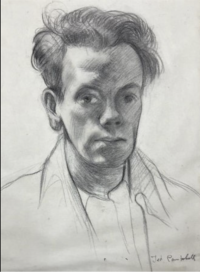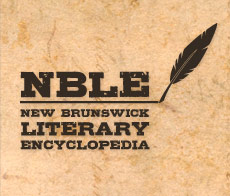Ted Campbell Studio

The Ted Campbell Studio – once located at 147 Prince William Street, Saint John, New Brunswick – was a midcentury locus for New Brunswick creativity and artistic support (Herring 98). Operated by Daniel Edwin (Ted) Campbell throughout the 1930s and 40s, the studio became one of the most important cultural epicenters in the province during its time, and ultimately inspired an exponential growth of artistic development on the east coast. Campbell’s studio was slave to no single discipline or aesthetic, which was a likely element of its success. Rather, artists of all persuasions, talents, and approaches were welcome there, as the diversity of the studio’s visitors acted not only as magnet but also inspiration for a larger creative community (Tremblay, New Brunswick at the Crossroads 110).
While there were many prominent artists and thinkers who frequented the studio (e.g., Miller Brittain, John Humphrey, Kjeld and Erica Deichmann, Phil Golding, Kelsey Jones, Avery Shaw, and Kathleen Shackleton), those of the literary persuasion were especially important to both east coast and national modernist progressions (New Brunswick at the Crossroads 110; Dearborn 22). In particular, “P.K. Page, Kay Smith, A.G. Bailey, ‘Thede’ Roberts (younger brother of Charles G.D.), and John Sutherland” were well acquainted with the culture of Campbell’s studio and were instrumental in extending its aesthetics beyond New Brunswick (New Brunswick at the Crossroads 110).
To fully understand Ted Campbell and the studio’s importance in incubating regional talent, one must consider Canada’s broader literary and arts cultures at that time, centered as they were in urban Ontario and Quebec. By the middle of the twentieth century, much of Canadian literary energies, for instance, had been dominated and influenced by a social and intellectual class of étudients, notably the first wave of Montreal modernists that were known as the McGill School. (An earlier “Fredericton” school of the Confederation poets led by Bliss Carman and Charles G.D. Roberts was similarly intellectual, indebted in that case to the Harvard Transcendentalists to whom both Carman and Roberts were related [Doyle 43, 50]). Yet Campbell’s aesthetic was different. In opposition to the centralizing, top-down intellectual models that defined the Confederation era, Campbell’s aesthetic promoted an unabashedly ground-up modernist sensibility that was as non-institutional as it was culturally syncretic.
To appreciate that decidedly small-r “republican” ethic – an ethic built from the diverse range of proficiencies of working-class artists – is thus to understand the studio’s relationship to larger 20th-century movements in Canadian art and publishing. With discrepancies of scale in mind – urban versus rural realities, for example, as well as the presence of national associations and institutions concentrated in central Canada – Campbell’s New Brunswick modernists focussed on building cultural infrastructure in the east. One such example was laying the groundwork for what would become The Fiddlehead, a literary magazine that was both founded and sustained by a number of Campbell-Studio attendees, such as Alfred G. Bailey, C.F. Boyle, and Elizabeth Brewster (Tremblay, The Fiddlehead Moment 116; Niergarth 182). Other such studio-inspired regional developments were the creation of Brunswick Press, the Maritime Art Association, and the Maritime Art magazine, as well as the opening of the Saint John chapter of the Canadian Authors Association and the establishment of the first-ever Fine Arts bachelor’s degree in Canada at Mount Allison University (New Brunswick at the Crossroads 13, 114-115; Niergarth 182).
Far from being confined to the east coast, the studio’s influence ranged further to touch artistic developments in 20th-century Quebec and Ontario. Most notably, regular Saint John studio attendees P.K. Page and John Sutherland would eventually move to Montreal to become critical players in the national modernist publishing community. While Page was a founding member of Preview magazine, Sutherland was the founder and first editor of First Statement, two of the earliest Canadian magazines dedicated exclusively to modern poetry. The very existence of those small-press journals brought new styles, writers, and readers to Canadian literature, changing the field for an entire generation (Irvine). Many of the familiar names of the post-war Canadian literary canon such as Raymond Souster, Louis Dudek, Miriam Waddington, and Irving Layton would become forever associated with the new critical modernism that those publications pioneered.
In tangible ways, then, Campbell’s regionally responsive, bottom-up modernism contributed to and was coincident with the second-generation Montreal modernism that sought to displace the academic and erudite poetics of the A.J.M. Smith and F.R. Scott generation. While that earlier generation of Canadian modernists were “following T.S. Eliot and the New Critics” with “depoliticized or decontextualized expression,” Campbell’s group rooted its alternative east-coast modernism in particular human and social concerns (New Brunswick at the Crossroads 111).
The core educational function of Campbell’s studio served that emphasis on the personal and became a vital part of Campbell’s higher artistic mission. According to Saint John artist Fred Ross, the studio was equal parts arthouse, music hall, and classroom, a place where young students and artists could regularly hear lectures from the premier artists of their time (Dearborn 22). In addition to the general clutter of instruments, art supplies, and furniture, the studio also housed an exceptional art library that Campbell encouraged all of his visitors to use (21). When combined with the weekly workshops and performances of skilled artists, this library ensured that education was always at the forefront. Ultimately, the “mixing of generations at the studio,” reported Karen Herring, “was one way in which Campbell wove the thread which connected promising art students with those dedicated to earning their living through art” (106-7).
Although it was one of many art rooms in “an era of studios in Saint John,” Campbell’s studio stands out both historically and culturally as the best and most influential (Dearborn 22). “It was opulent and yet it was warm,” remembered Campbell-trained artist Jim Stackhouse (qtd. in Dearborn 21), and “whenever anyone of note was coming to town, people called up and asked if they could bring them to Ted’s studio” (Fred Ross, qtd. in Dearborn 21). While it is difficult to quantify the literary, cultural, and artistic influence it had in New Brunswick and beyond, there is little doubt that Ted Campbell’s Studio enabled the work of a whole generation of artists, thereby contributing to the direction of art in this country. Today, a parking lot sits where the studio was housed.
Jake Dow, Fall 2022
Fredericton, NB
Bibliography of Secondary Sources
Dearborn, Dorothy. “Two Saint John Artists Look Back and Ahead.” Atlantic Advocate 70.7 (March 1980): 20-24.
Doyle, James. “Bliss Carman and the American Literary Milieu of the 1890s.” Bliss Carman: A Reappraisal. Ed. Gerald Lynch. Ottawa: U of Ottawa P, 1990. 43-52.
Herring, Karen. “Creating a Centre/Recreating the Margin: Ted Campbell and His Studio, Saint John, New Brunswick, In the 1930s and 40s.” MA thesis. Carleton University, 1993.
Hill, Charles. “Interview with Ted Campbell.” 29 October 1973. Canadian Painting in the Thirties. National Gallery of Canada Fonds. LAC. 1-51. Exhibition Records, National Gallery of Canada, Ottawa.
Irvine, Dean. “‘Little Magazines’ in English Canada.” The Oxford Critical and Cultural History of Modernist Magazines. Vol. 2: North America 1894-1960. Ed. Peter Brooker and Andrew Thacker. Oxford: Oxford UP, 2012. 602-628.
Niergarth, Kirk. “The Dignity of Every Human Being”: New Brunswick Artists and Canadian Culture between the Great Depression and the Cold War. Toronto: U of Toronto P, 2015.
Percival, Robert. “The Fugitive Tradition in Saint John.” Arts Magazine 7.25 (March/April 1976): 46-51.
Sweet, Jean M. “Ted Campbell’s Studio.” Atlantic Advocate 59.7 (March 1969): 30-35.
Tremblay, Tony. “Mid-Century Emergent Modernism, 1935-1955.” New Brunswick at the Crossroads: Literary Ferment and Social Change in the East. Ed. Tony Tremblay. Waterloo, ON: Wilfrid Laurier UP, 2017. 101-127.
---. The Fiddlehead Moment: Pioneering an Alternative Canadian Modernism in New Brunswick. Montreal & Kingston: McGill-Queen's UP, 2019.


